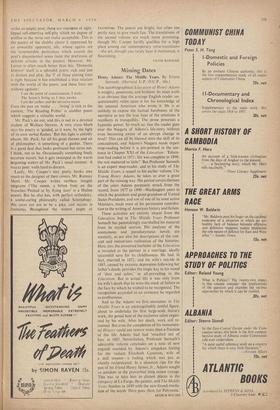Missing Dates THE autobiographical Education of Henry Adams is weighty,
pessimistic and brilliant. Its inner truth is so obvious that the average English reader un- questionably relies upon it for his knowledge of the unusual American who wrote it. He is as unlikely to expose the factual barebones of the narrative as test the true heat of the emotions it recollects in tranquillity. The prose possesses a hypnotic power. So much so, that the reader goes over the Niagara of Adams's life-story without even becoming aware of an abrupt change in level ! This can all be. blamed onto the skill of its concealment, and Adams's Niagara needs expert map-reading before it is pin-pointed in the sen- tence in Chapter XXI of the Education: 'Educa- tion had ended in 1871; life was complete in 1890; the rest mattered so little!' But Professor Samuels is an expert map-reader, and in his study of The Middle Years, a sequel to his earlier volume The Young Henry Adonis, he takes us over a great part of the missing way. His period covers thirteen of the years Adams purposely struck from the record, from 1877 to 1890—Washington years in which the grandson and great-grandson of United States Presidents, and son of one of its most active Ministers, made most of his permanent contribu- tion to the writing of American history and fiction.
These activities are entirely absent from the Education, but in The Middle Years Professor Samuels has painstakingly marshalled his material from its myriad sources. His analyses of the anonymous and pseudonymous novels are masterly, as are also his descriptions of the con- cept and industrious realisation of the histories. Here, too, the presumed bachelor of the Education is revealed as the partner in a marriage, ideally successful save for its childlessness. He had, in fact, married in 1872, and his wife's suicide in 1885, caused by extreme depression following her father's death, provides the tragic key to his mood of 'dust and 'ashes,' so all-prevailing in the Education. But in actual life it was only from his wife's death that he wore the mask of failure as the face by which he wished to be recognised. The recognition accorded to an existence he regarded as posthumous.
And so the Adams we first encounter in The Middle Years is an unrecognisably zestful figure, about to undertake his first large-scale literary work, the genial host of the exclusive salon organ- ised by his wife. After her death, work still re- mained. But even the completion of his monumen- tal History could not restore more than a fraction of the life Adams had had 'smashed out of him' in 1885. Nevertheless, Professor Samuels's admirable volume concludes on a note of new anguish sounded by Adams's unspoken feeling for the radiant Elizabeth Cameron,. wife of a dull senator—a feeling which was just as silently reciprocated. In a situation ripe for the pen of his friend Henry James, Jr., Adams sought an antidote in the proverbial long ocean voyage. This was to take him to distant places in the company of La Farge, the painter, and The Middle Years finishes in 1890 with the new-found resolu- tion of the words 'Here goes, then, for Polynesia.'
ARTHUR BOYARS


































 Previous page
Previous page